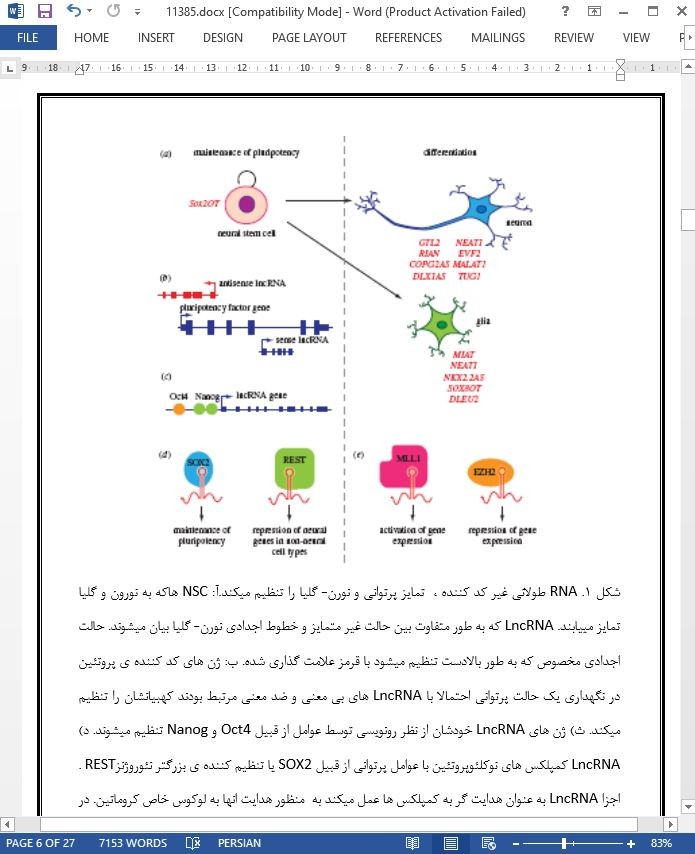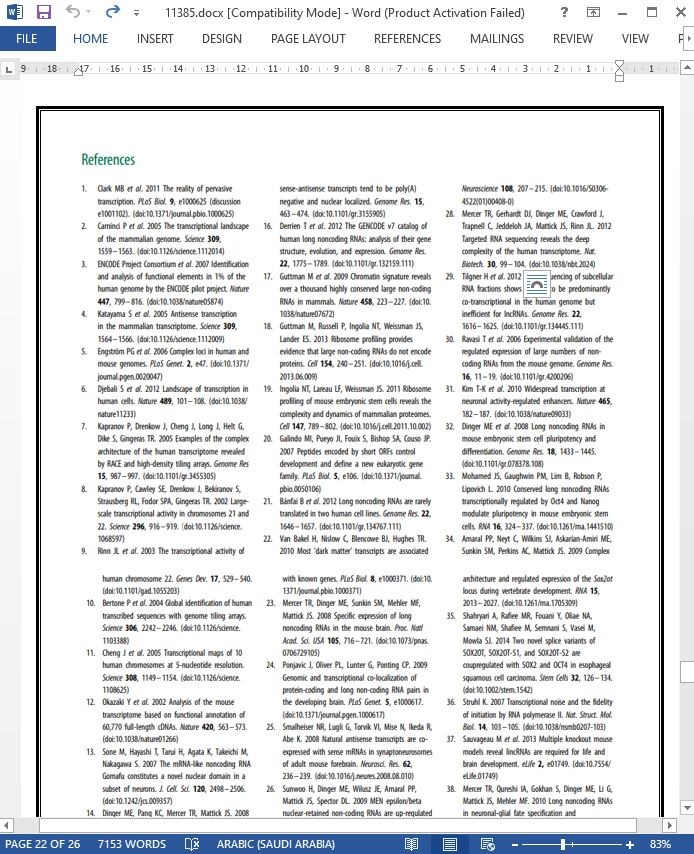
نقش RNA های غیرکد کننده طویل در تکوین نورون، عملکرد مغز و بیماری عصبی
RNA های غیرکدکننده lncRNAs رونوشت هایی با پتانسیل پایین کدشوندگی به پروتئین هستند که بخش وسیعی از بازده رونویسی سلول را نشان میدهند. بسیاری از lncRNAs ویژگیهایی را در معرض نمایش قرار میدهند که که نشانگر عملکرد هایی مانند بیان محدود به بافت، محل یابی ساختارهای تحت سلولی واضح ، تنظیم بیان و حفاظت تکاملی هستند. برخی از lncRNAs ها نشان داده شده که با فعالیت های اصلاح کننده ی کروماتین و عوامل رونویسی ارتباط دارد که پیشنهاد میکند که یک حالت رایج عملکرد احتمالا کمپلکس پروتیئن هارا به جایگاه ژنی هدف هدایت میکند. اگرچه؛ عملکردهای اکثریت رونوشت های lncRNAs شناخته شده نیستند و اکنون موضوع پژوهش ها هستند. اینجا، ما عملکردهای lncRNAs در تکوین عصب و عملکرد مغز را با تاکید بر تنظیم اپی ژنتیک بیان ژن در نظر گرفتیم. ارتباط lncRNAs با تکوین نورون / اختلالات عصبی ، از بین رفتن نورون ها و سرطان مغز همچنین بحث شده است.
مقدمه
اکنون مشخص است که اکثریت ژنوم پستانداران، رونوشت های RNA را تولید میکند درحالیکه تنها 1 % از توالی DNA پروتئین ها را کد میکنند (حالتی که بهعنوان رونوشت فراگیر معروف است) اکثریت لوکوس ها ، شبکه ی درهم فشرده ای را تولید میکنند و رونوشت ها را در هر دو جهت معنی دار و بی معنی همپوشان میکنند. نتایج مکمل با استفاده از روش¬های رونویسی مشاهده شده است: از قبیل RNA-seq، RNA tiling arrays، توالی یابی کامل کتابخانه ی cDNA ، مضاعف سازی سریع انتهای cDNA (RACE) و توالی یابی علائم RACE که پیشنهاد میکند که رونویسی های مشاهده شده واقعی هستند و تکنیک مصنوعی یا زمینه ی ژنوم DNA/pre-Mrna نیستند.
8 نتیجه گیری
به طور خلاصه، قضیه این است که lncRNAs عملکردی هستند و این توسط روش زیر حمایت میشوند: 1) الگوهای بیان موقتی و مخصوص 2) فرآیند رونوشت مرگ و میر بالا. 3)بیان متمایز در طول فرآیندهای سلولی 4) حفاظت تکاملی 5) مدل های موش دستکاری شده 6) از دست دادن عملکرد RNAi 7) مطالعات هم¬بیانی guilt-by-association 8) بر همکنش های پروتیئن های اطلاح کننده ی کروماتین و TF 9) دخالت در بیماریزای آن و 10) مطالعات متمرکز شده عملکرد در موارد خاص را نشان میدهد .
Long non-coding RNAs (lncRNAs) are transcripts with low protein-coding potential that represent a large proportion of the transcriptional output of the cell. Many lncRNAs exhibit features indicative of functionality including tissue-restricted expression, localization to distinct subcellular structures, regulated expression and evolutionary conservation. Some lncRNAs have been shown to associate with chromatin-modifying activities and transcription factors, suggesting that a common mode of action may be to guide protein complexes to target genomic loci. However, the functions (if any) of the vast majority of lncRNA transcripts are currently unknown, and the subject of investigation. Here, we consider the putative role(s) of lncRNAs in neurodevelopment and brain function with an emphasis on the epigenetic regulation of gene expression. Associations of lncRNAs with neurodevelopmental/neuropsychiatric disorders, neurodegeneration and brain cancers are also discussed.
1. Introduction
It is now clear that the majority of the mammalian genome produces RNA transcripts despite only approximately 1% of the DNA sequence encoding proteins (a phenomenon known as pervasive transcription) [1]. The majority of loci produce a forest of interlaced [2] and overlapping [3] transcripts in both sense and antisense orientations [4,5]. Complementary results have been observed using multiple transcriptomics methodologies (i.e. RNA-seq [6], RNA tiling arrays [3,7– 11], sequencing of full-length cDNA libraries [2,12], high-throughput rapid amplification of cDNA ends (RACE) [7] and sequencing of CAGE tags [2]) suggesting that the observed transcription is real and not a technical artefact or background genomic DNA/pre-mRNA.
8. Conclusion
In summary, the proposition that lncRNAs are functional is supported by the following: (i) specific spatial and temporal expression patterns, (ii) high-fidelity transcript processing, (iii) differential expression during cellular processes, (iv) evolutionary conservation, (v) knockout mouse models, (vi) RNAi loss-of-function screens, (vii) guilt-by-association co-expression studies, (viii) interactions with chromatin-modifying proteins and TFs, (ix) implication in disease pathophysiology and (x) focused studies demonstrating function in specific cases.
چکیده
1. مقدمه
2. آیا RNA های غیر کدکننده عملکردی هستند ؟
3. عملکرد RNA های غیرکد کننده طویل چیست؟
4. RNA طویل غیر کد کننده در تکوین نورون و عملکرد مغز درگیرند
5. RNA طولانی غیر کد کننده و تجزیه نورون
6. RNA غیر کد کننده طویل و اختلالات تکوین نورون / neuropsychiatric
7. RNA غیر کد کننده ی طویل و سرطان مغز
8 نتیجه گیری
1. Introduction
2. Are long non-coding RNAs functional?
3. What are the functions of long non-coding RNAs?
4. Long non-coding RNAs are involved in neural development and brain function
5. Long non-coding RNAs and neurodegeneration
6. Long non-coding RNAs and neurodevelopmental/neuropsychiatric disorders
7. Long non-coding RNAs and brain cancers
8. Conclusion
- اصل مقاله انگلیسی با فرمت ورد (word) با قابلیت ویرایش
- ترجمه فارسی مقاله با فرمت ورد (word) با قابلیت ویرایش، بدون آرم سایت ای ترجمه
- ترجمه فارسی مقاله با فرمت pdf، بدون آرم سایت ای ترجمه



